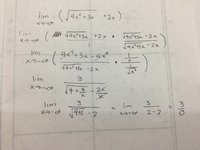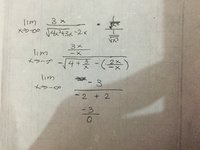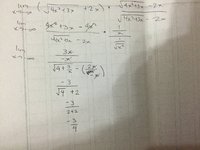You are using an out of date browser. It may not display this or other websites correctly.
You should upgrade or use an alternative browser.
You should upgrade or use an alternative browser.
Find the limit
- Thread starter Wahamuka
- Start date
Harry_the_cat
Elite Member
- Joined
- Mar 16, 2016
- Messages
- 3,779
Multiply by conjugate/conjugate to get a rational expression with no sqrt on numerator.
Dr.Peterson
Elite Member
- Joined
- Nov 12, 2017
- Messages
- 16,865
Another thing you might try is a change of variables. Consider letting x = 1/u, and finding the limit as u goes to 0 from below. This will require some care, but it's a useful trick sometimes just to try making the expression look different. (The different form will suggest the conjugate method, if you hadn't thought of it before.)
Dr.Peterson
Elite Member
- Joined
- Nov 12, 2017
- Messages
- 16,865
When x is negative, [MATH]\sqrt{x^2}\ne x[/MATH]!
Most of your work looks good, although you made a sign error in the third line. For \(x < 0\), we have \(\displaystyle \frac{1}{\sqrt{x^2}} = \frac{1}{|x|} = \frac{1}{-x}\), so you (effectively) multiplied by \(\displaystyle \frac{1}{-1}\) which necessarily changes the value of the limit.
Secondly, there's another sign error in fourth line. For \(x < 0\), we have \(\displaystyle \sqrt{4x^2+3x}\cdot\frac{1}{x} = -\sqrt{4+\frac{3}{x}}\).
If you fix both these sign errors, you'll find the correct answer.
Secondly, there's another sign error in fourth line. For \(x < 0\), we have \(\displaystyle \sqrt{4x^2+3x}\cdot\frac{1}{x} = -\sqrt{4+\frac{3}{x}}\).
If you fix both these sign errors, you'll find the correct answer.
What I got in this question was positive infinity but I know its wrong. I just don’t know what the first steps are to solve this problem pls give tips
Also, if you know how to use the binomial theorem, what you're taking the limit of becomes
\(\displaystyle 2|x| \ + \ \dfrac{3}{4}\cdot\dfrac{x}{|x|} \ - \ \dfrac{9}{64}\cdot\dfrac{1}{|x|} \ + \ [only \ terms \ with \ the \ degree \ of \ the \ denominator \ is \ greater \ than \ 1] \ + \ 2x\)
As x approaches negative infinity, it can simplify further along to this:
the limit as x approaches negative infinity of \(\displaystyle \ \dfrac{3}{4}\cdot\dfrac{x}{|x|} \)
Continue . . .
Wahamuka
New member
- Joined
- Jan 19, 2019
- Messages
- 28
I still don’t get it. What did I do wrong now?
Can you guys show your solution for this because I really don’t understand that concept of when x<0 then it the squareroot will be negative. I have another question like this I would like to solve so I just need to understand this
Can you guys show your solution for this because I really don’t understand that concept of when x<0 then it the squareroot will be negative. I have another question like this I would like to solve so I just need to understand this
Attachments
Harry_the_cat
Elite Member
- Joined
- Mar 16, 2016
- Messages
- 3,779
" I really don’t understand that concept of when x<0 then it the squareroot will be negative."
-x is not always a negative number
If say x=3, then -x = -3 but if x = -3 then -x =+3
If x is negative then -x is positive.
No-one has said that " when x<0 then it the squareroot will be negative"
In fact when talking about real numbers, the squareroot of something is always positive (or zero).
So, \(\displaystyle \sqrt {x^2} = | x |\) and \(\displaystyle | x | = x \) if x>0 but \(\displaystyle | x | = -x\) if x<0.
It's like \(\displaystyle \sqrt {(-3)^2} = - -3 = 3\).
As Dr P said in Post #5 :
-x is not always a negative number
If say x=3, then -x = -3 but if x = -3 then -x =+3
If x is negative then -x is positive.
No-one has said that " when x<0 then it the squareroot will be negative"
In fact when talking about real numbers, the squareroot of something is always positive (or zero).
So, \(\displaystyle \sqrt {x^2} = | x |\) and \(\displaystyle | x | = x \) if x>0 but \(\displaystyle | x | = -x\) if x<0.
It's like \(\displaystyle \sqrt {(-3)^2} = - -3 = 3\).
As Dr P said in Post #5 :
Dr.Peterson
Elite Member
- Joined
- Nov 12, 2017
- Messages
- 16,865
You've corrected the errors except for one place. There should not be a "-" before the radical on the second line. Did you have a reason to put it there?I still don’t get it. What did I do wrong now?
Can you guys show your solution for this because I really don’t understand that concept of when x<0 then it the squareroot will be negative. I have another question like this I would like to solve so I just need to understand this
Wahamuka
New member
- Joined
- Jan 19, 2019
- Messages
- 28
You've corrected the errors except for one place. There should not be a "-" before the radical on the second line. Did you have a reason to put it there?
I put the negative there because ksdhart2 said in his second to the last line post.
" I really don’t understand that concept of when x<0 then it the squareroot will be negative."
-x is not always a negative number
If say x=3, then -x = -3 but if x = -3 then -x =+3
If x is negative then -x is positive.
No-one has said that " when x<0 then it the squareroot will be negative"
In fact when talking about real numbers, the squareroot of something is always positive (or zero).
So, \(\displaystyle \sqrt {x^2} = | x |\) and \(\displaystyle | x | = x \) if x>0 but \(\displaystyle | x | = -x\) if x<0.
It's like \(\displaystyle \sqrt {(-3)^2} = - -3 = 3\).
As Dr P said in Post #5 : View attachment 12903
Also oof thats some weird typo I got
Is my solution correct now?
Attachments
Dr.Peterson
Elite Member
- Joined
- Nov 12, 2017
- Messages
- 16,865
Yes, that's correct. But do you see exactly why the negative should not be there? It may help if you write out some intermediate steps.
The key part is [MATH]\sqrt{4x^2+3x}\cdot\frac{1}{\sqrt{x^2}} = \sqrt{\frac{4x^2+3x}{x^2}} = \sqrt{4+\frac{3}{x}}[/MATH]. There is no place for a negative to appear from nothing!
The key part is [MATH]\sqrt{4x^2+3x}\cdot\frac{1}{\sqrt{x^2}} = \sqrt{\frac{4x^2+3x}{x^2}} = \sqrt{4+\frac{3}{x}}[/MATH]. There is no place for a negative to appear from nothing!
Harry_the_cat
Elite Member
- Joined
- Mar 16, 2016
- Messages
- 3,779
??Also oof thats some weird typo I got
Wahamuka
New member
- Joined
- Jan 19, 2019
- Messages
- 28
Why do you apply the squareroot of x^2 = negative x only when the number you are multiplying is not in a squareroot. For example in my most recent picture, 3rd line I put (2x/-x) but I didnt put a negative before the squareroot or even inside of it
Dr.Peterson
Elite Member
- Joined
- Nov 12, 2017
- Messages
- 16,865
I hadn't noticed that your second line there was wrong; you really multiplied by [MATH]\frac{\frac{1}{\sqrt{x^2}}}{\frac{1}{\sqrt{x^2}}} = \frac{\frac{1}{-x}}{\frac{1}{\sqrt{x^2}}}[/MATH], since for negative x, [MATH]\sqrt{x^2} = |x| = -x[/MATH]. On the next line, the negative is there where it should be.
Anyway, on the third line you have replaced [MATH]\sqrt{x^2}[/MATH] with its equal, [MATH]-x[/MATH]. You didn't put a negative before the remaining radical because it was never there! Why would you change the sign of anything? I showed you how to handle the radical in post #12; at no point are you replacing anything with something negative.
You seem to be thinking a little in terms of magic, as if some "rule" changes things to things they are not. No; at every step, you are replacing things only with equal quantities; each of those has its own reason for being equal, which you have to carefully consider.
Anyway, on the third line you have replaced [MATH]\sqrt{x^2}[/MATH] with its equal, [MATH]-x[/MATH]. You didn't put a negative before the remaining radical because it was never there! Why would you change the sign of anything? I showed you how to handle the radical in post #12; at no point are you replacing anything with something negative.
You seem to be thinking a little in terms of magic, as if some "rule" changes things to things they are not. No; at every step, you are replacing things only with equal quantities; each of those has its own reason for being equal, which you have to carefully consider.
Harry_the_cat
Elite Member
- Joined
- Mar 16, 2016
- Messages
- 3,779
So what even is the answer to this problem? I think im on a wild goose chase. The ans is -3/4 right?
Did you look at my post # 7!?




